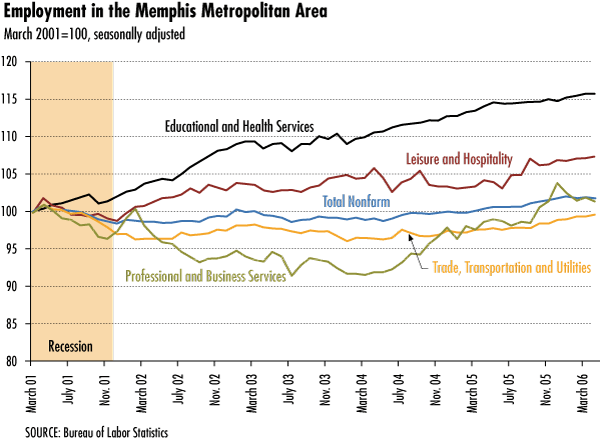District Overview: Professional and Business Services Bounce Back in Memphis
Total employment in the Memphis metropolitan area has been recovering steadily since the 2001 recession. Two sectors have led the way: educational and health services, followed by leisure and hospitality. More recently, however, the professional and business services sector has created a significant number of jobs as well. The largest sector in the Memphis economy—trade, transportation and utilities—has yet to return to its pre-recession employment level.
The recession, which lasted from March 2001 to November 2001, barely affected educational and health services employment. This sector, which represents about 12 percent of total nonfarm jobs in the Memphis area, actually added about 800 jobs (1.3 percent) during the recession. Between November 2001 and April 2006, this sector added about 9,300 jobs—1,100 of which were added since April 2005.
The leisure and hospitality sector, which represents about 11 percent of total nonfarm employment, also weathered the 2001 recession fairly well. Fewer than 600 jobs (1 percent) were lost during the recession. Between November 2001 and April 2006, this sector also did quite well, adding about 5,300 jobs—2,100 jobs of which were added since April 2005.
The professional and business services sector received one of the hardest blows during the recession. This sector, responsible for 12 percent of total nonfarm jobs, lost about 2,900 jobs (3.7 percent) during the 2001 recession and continued to lose jobs after the recession was over. Between November 2001 and March 2004, this sector lost an additional 3,700 jobs. Since then, employment has grown by a whopping 10.7 percent, a total of about 7,600 new jobs, which more than makes up for the total loss of about 6,600 jobs between March 2001 and March 2004. Many of the new jobs were in the professional, scientific and technical services sector, which includes the logistics and medical research industries. Both of these industries are thriving in Memphis.
Employment in the manufacturing sector, which now comprises less than 9 percent of total nonfarm employment, started to decline in the late 1990s and took a serious tumble during the 2001 recession. This sector lost about 2,800 jobs (4.6 percent) during the recession and about 4,100 additional jobs between November 2001 and January 2004. This sector stabilized in the past two years, gaining about 800 jobs between January 2004 and April 2006.
The trade, transportation and utilities sector, the largest in the Memphis economy, has not fared well since the 2001 recession. As of April 2006, only about 74 percent of the jobs lost during the recession were recovered, as the sector grew by only 1.6 percent between November 2001 and April 2006. The performance of this sector reflects in part recent national trends in the costs of shipping, warehousing and demurrage, as well as a nationwide shortage of truck drivers. The Memphis economy is, however, more dependent on this sector than the nation as a whole. At the national level, this sector represents about 19 percent of nonfarm employment, compared with 28 percent in Memphis. At the national level, this sector grew by 1.4 percent between November 2001 and April 2006 and recovered about 70 percent of the jobs lost during the recession.
Despite a lagging trade, transportation and utilities sector, employment in Memphis has been growing in the past two years. Over this period, the professional and business services sector, one of the more sluggish sectors in the aftermath of the recession, has become one of the three leading job-creating sectors in the Memphis economy.

Views expressed in Regional Economist are not necessarily those of the St. Louis Fed or Federal Reserve System.
For the latest insights from our economists and other St. Louis Fed experts, visit On the Economy and subscribe.
Email Us

